
The eyes have it. And by it, I mean our interest, our attention, and even our love. Anime and manga uses eyes as the foundation for character expressions. Eyes dominate most character faces, especially moe characters. Because of the expressiveness of eyes, the dominance is logical. But enormous eyes can unsettle and put off people unfamiliar with anime. Clannad‘s eye designs provide a good example of this. The larger space allows artists to stuff more detail into the eye designs. The detail allows for more personality and include plot elements such as the eyes we see in Naruto and Code Geass. Mengo Yokoyari, the illustrator behind Oshi no Ko, Scum’s Wish, and other titles, leverages the large eyes trope to elevate expressiveness. She uses the extra space to illustrate windows to the characters’ implied inner lives. Naturalistic eye designs cannot be as expressive–not to say they are cannot be expressive. They don’t communicate with the same clarity as anime’s large eye designs can. This can be useful for a story if the writer needs characters to be mysterious. Character designs should serve the narrative. A good design fits the story and the personalities pushing the narrative forward. Ai, Aqua, and Ruby’s eye designs, for example, in Oshi no Ko become a inseparable from the narrative. Characters even comment about the allure of their eyes, and their eyes reveal more than their actions and words. Mengo Yokoyari’s designs in Oshi no Ko sets a new standard in how anime eyes can develop characters.
Large eyes denote innocence and youthfulness. You see older characters and male characters with naturalistic eye sizes. Males have smaller eyes than females do. Narrow eyes can denote evil, hidden motives, or emotional separation. Such characters may hide a softer side, like Pokemon’s Brock does. At first, he puts up a tough front as a gym leader, but he’s really a softy toward women and his siblings. Bleach‘s Gin Ichimaru has narrow eyes, showing how he keeps himself separated from everyone and his true motives hidden. Large, open eyes suggest the character has nothing to hide. But good writers will use the narrow and large eye expectations to their advantage. Villains can hide behind big, seemingly open eyes. Heroes can hide behind narrow slits. This, however, can also become a trope when overused. Large eyes appear in animals and newborns, which prompt us to feel protective toward them. They cause an emotional connection. The design has become ubiquitous to the point where you can’t imagine anime and manga without it.
Anatomically, large eyes create skulls not unlike owl skulls or deer skulls. The orbital socket of the eye is much larger than what we see. Muscles wrap the eyeball and hold it in place. We see little of the eyeball.Our minds know this is unnatural, which leads us to feel unsettled with, say, Clannad‘s character designs. A good writer can use this unsettled feeling to push the audience toward a narrative point.
Anime eyes exaggerate and simplify human eye signals. Genuine smiles make the eyes crinkle. Anger makes eyebrows draw down and the muscles around the eyes contract. Shocked eyes widen. The lower lids of crying eyes quiver with the person’s quivering lips. Where muscles would crinkle and overlap, anime eyes simplify this into a single expressive line under a narrowed eye. This simplification eases your ability to read the character. Anime eyes can show two or even three emotions at once, just as the human eye can. But anime can achieve this (if the artist is skillful) with a minimum of lines. For people who struggle to read emotions, anime eye designs provide a useful learning tool.
Examples of Interesting Eye Designs
Most anime characters fall into a standard eye design, which I use Taga Aisaka from Toradora as the example of this design.
Taiga Aisaka, Toradora!

Taiga’s eyes provide a good example of the most common design. Her eyes provide expression through simplicity. Her eyes are large but not as large as past moe designs. Her eyes contain 3 tones: brown-black and 2 shades of brown. But the 3 tones, when combined with the life-producing highlight, suggest depth to her irises. Taiga’s eyes express a range of emotions, including tearful anger. Eyebrows and eyelid suggestions shift and add complications to her emotions. Hesitancy, for example, can include some irritation thanks to eyebrow angle. Taiga’s eye design shows how flexible simplicity can be.
Tohru Honda, Fruits Basket
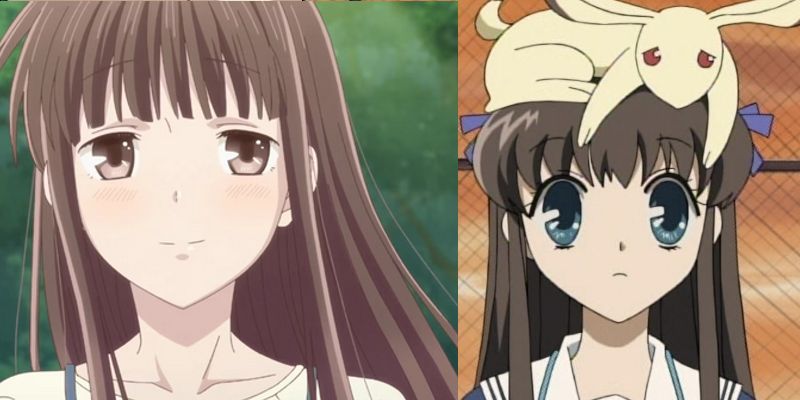
Tohru offers an interesting contrast in design changes over time. On the left, we see Tohru from the recent remake of Fruits Basket. On the right, we see the original anime design with her enormous eyes. The remake takes a more naturalistic approach, even with her still too-large eyes. Modern Tohru’s eyes have more depth than her original design. Both use 3 colors. Notice how modern Tohru appears to be older than her previous design. Tohru shows how design choices shift the feel of a character. Tohru feels more innocent and less guarded in her previous incarnation. While I prefer Tohru’s modern design and her brown eyes over her blue, both designs work for the angle of the Fruits Basket story. The original (It’s been years since I’ve seen it) leans toward comedy more than the modern version does. The original design fits fine for that angle, but it wouldn’t have worked for the more serious take the modern remake leans into.
Gin Ichimaru, Bleach

Gin has the narrow eye look down. The design hides his true emotions, and sometimes he opens his eyes wide enough for the audience to see his pupils and iris. Gin appears as a villain, which is common for narrow-eyed characters. His design also taps into the blind-swordsman idea because his eyes aren’t just narrowed. They’re closed. Despite this, he is, perhaps, one of the most observant characters in Bleach. His eye design contrasts his character. His eye design keeps him mysterious and interesting. Most narrow-eyed characters function more like Pokemon’s Brock. Their eyes aren’t closed. Their eyes are narrow. But despite the extreme minimalism of this design, muted emotions can still come through.
Yubaba, Spirited Away
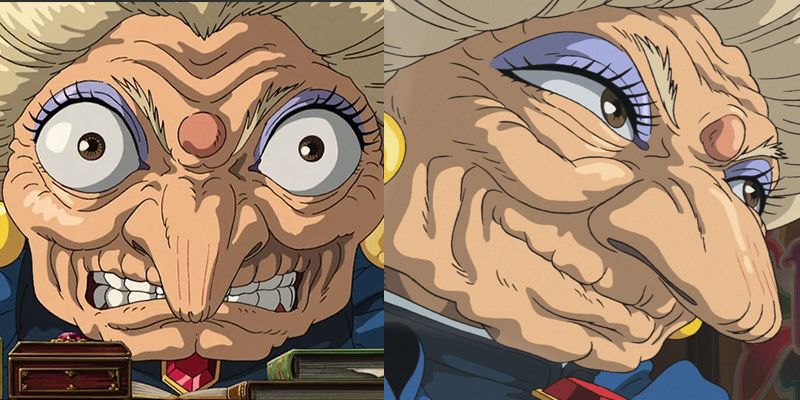
Most anime characters are young. Old characters use a few extra lines to denote their age. Yubaba, on the other hand, shows wrinkles on wrinkles. Her enormous eyes sit among these wrinkles to create an expressive personality. Her irises are as complex as Taiga’s irises with 3 colors and a highlight. Yubaba’s wrinkles support her eye expressiveness. Otherwise, her eyes fall into standard anime design patterns. Yubaba is a fun character to watch with how Studio Ghibli handles her facial animations.
Ed, Cowboy Bebop
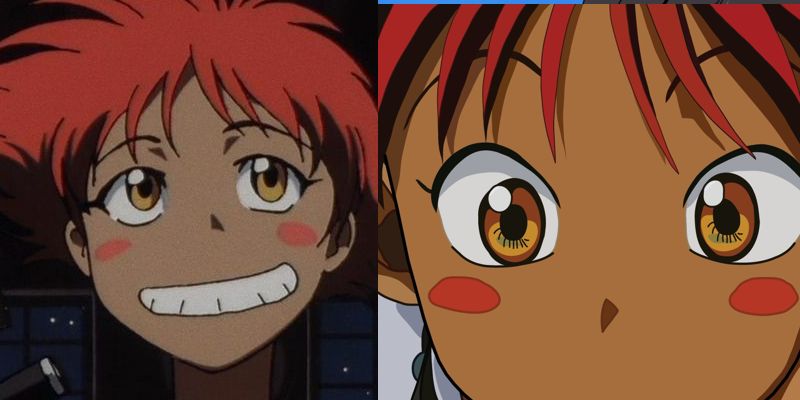
Ed provides another example of a standard eye design. Ed’s eyes include 3 colors and a highlight with details increasing during close ups. Ed’s design remains simple with a few curved lines to suggest iris detail. Despite the similarities with Taiga, Ed’s eye design shows a different personality thanks to her supporting facial features. Anime eye design offers flexibility with how other facial elements can shift them–Ed’s smile, for example. Because anime is so spare in design, even a single line can change a face’s personality.
Hinata, Naruto
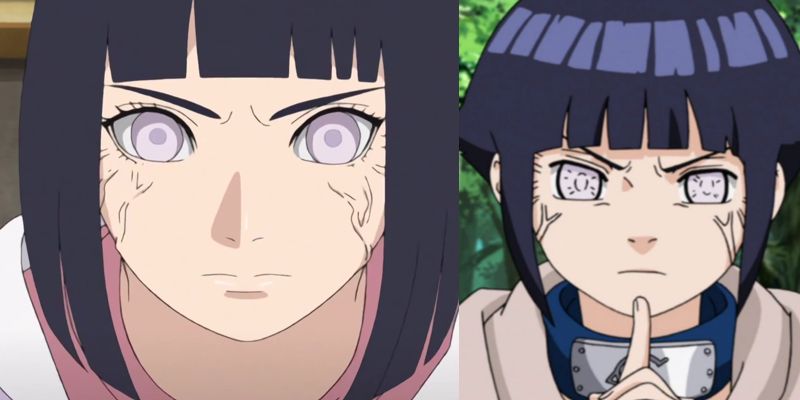
Hinata’s eyes reduce to just 2 colors, which gives her an interesting contrast. Her eyes, otherwise, fall into standard design. Her powers create veins along her face which point toward her eyes. This further emphasizes her unique color design. Hinata proves the rule that even a few lines can shift how a character reads. Compare her younger eye design to her mature eye design. In her mature design, she has longer eyelashes and more confidence. She’s not trying as hard to achieve the same effect. In her younger design, the bold lines suggest her level of effort. Line thickness can suggest many different things. Thick lines can denote fleshiness. A thin line can suggest bone. In Hinata’s case, her younger self still has some baby fat denoted by the thicker line quality along her jawline. All of this applies to eye design too. Line quality influences how eyes read.
Lelouch, Code Geass

Lelouch’s eye design features 3 colors for his normal eye and 3 more for his Geass eye. The contrast between purple and purple-red gives him a sinister feeling, which works with his ends-over-means approach to his goals. Notice how his Geass eye lacks a highlight. In anime eye designs, the highlight stands in for life. Unconscious or dead characters lack this highlight. It creates a dead look to their eyes. Lelouch’s Geass eye looks dead compared to his natural eye. The wing symbol in the eye adds to the otherwordly, artificial quality. Notice how the rule of simplicity still applies to his eyes. Even the Geass eye remains simple. Simplicity creates immediate communication.
Nia Teppelin, Gurren Lagann
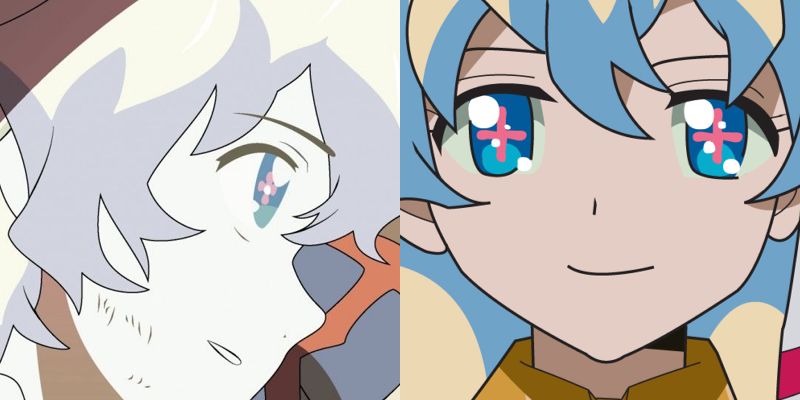
Nia steps into a more complex design, building on a symbol design as a part of her personality. Her eyes substitute a flower shape for her pupils. Her eyes use 4 colors and several highlights. The highlights give her eyes a sparkle. This symbolizes her liveliness. Nia effuses life. Her flower-shape pupil underpins this, giving her extra interest. Her eyes attract. Her flower-pupils slightly change the standard eye design. But small changes matter for characters.
Violet, Violet Evergarden

Violet’s eyes feature thick, black lashes to set off the blues of her irises. Her eyes feature 5 colors with 2-color highlights. This creates a gem-like quality to her eyes when combined with her thick lashes. Her eyes appear deep when the camera pulls back. There’s an iciness to her eyes. The multiple highlights, just like with Nia, suggest an effusion of life. Because of the jewel quality of her eye design, when Violet cries, her tears pull at the audience’s tears. We finally see under the ice when her tears fall. Violet doesn’t have as large and exaggerated eyes as other characters. She isn’t innocent. Her thick lashes work to narrow her eyes. Her lashes take up half the height of her irises. The lashes lend weight and maturity.
Kaguya, Kaguya-sama: Love is War
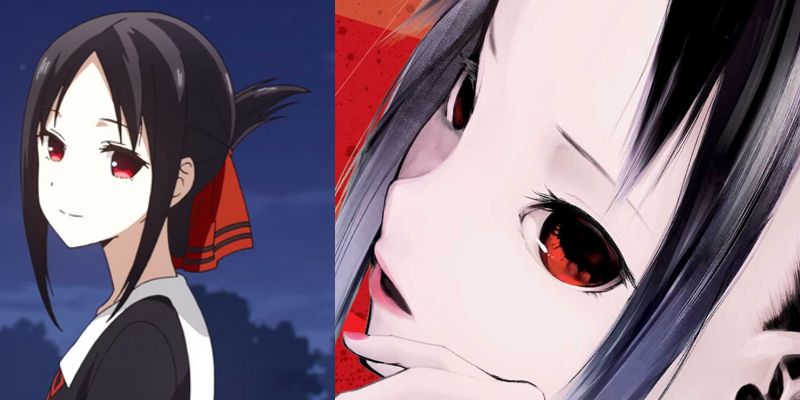
Kaguya’s red eyes look otherworldly. Red eyes, after all, are rare among humans. Kaguya’s eyes have 4 colors with her pupils blending into the purple-red shadows cast by her thick lashes. The suggestion of pupils makes her eyes look more unreadable. This design choice contrasts with how she’s the main point-of-view character of the story. Her thick lashes and deep shadows serves a similar purpose for Kaguya as they do for Violet. They work to narrow her large eyes and add to her disconnect with reality. Kaguya-sama plays with Kaguya’s eyes throughout the story. She will lose her highlights when her mind goes blank. She will sometimes have pupils set against solid-color irises to show her shock or overwhelmed feelings. This all works because of the contrast her normal guarded eyes offers.
Ai, Oshi no Ko
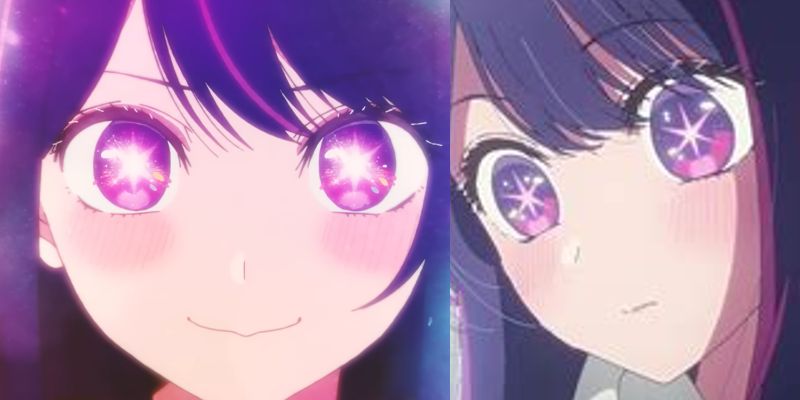
Ai’s eyes present the most complex design. She takes Nia’s pupil design and expands it into a luminous star. Depending on the scene, you can find 5 to 10 colors plus highlights. Ai’s eyes shimmer. The design both attracts and pushes the viewer away. Ai becomes too different, yet people find stars attractive and fascinating. Ai’s eyes play a key role in the plot. They lie. Her eye design creates one of the most unsettling scenes I’ve seen in film. Her large eyes hide as much as Gin’s narrow eyes do. Ai proves huge anime eyes can be works of art themselves. Her design proves how art can move us.
Literary Souls
Characters don’t have souls, but they exist within narratives that can feel more alive than life feels. Stories spice our everyday experience. Characters cannot have the complexity real people have, but they point us toward appreciation for human complexity. Characters offer places to explore our relationships with people. They provide valuable life lessons while entertaining us. Learning to empathize with characters help us learn to empathize with others. The simplified nature of anime eyes makes the visual language of human eyes easier to spot. The verbs and nouns are the same no matter how obscured in adjectives they may be. Reading people’s faces isn’t easy and takes practice. For some, characters provide a safe place to practice. Stories also provide moral lessons and education. In the ancient world, literature formed the foundation for education: Illiad and Odyssey, Nihon Shoki and Kojiki . We learn by experience, even when that experience is a story. Understanding anime eyes, in other words, is a skill that helps you learn to read people’s eyes.


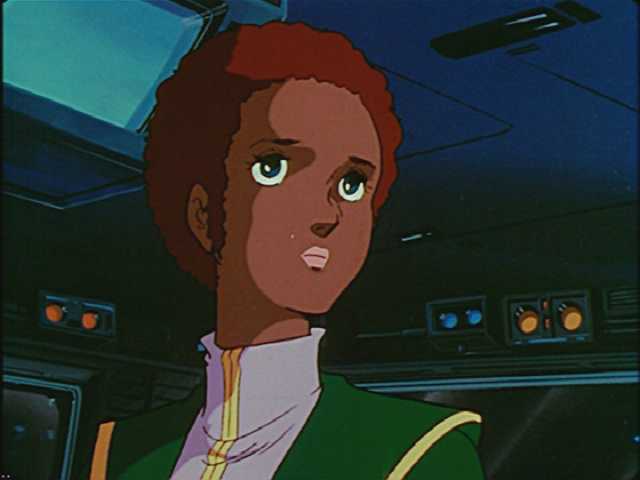
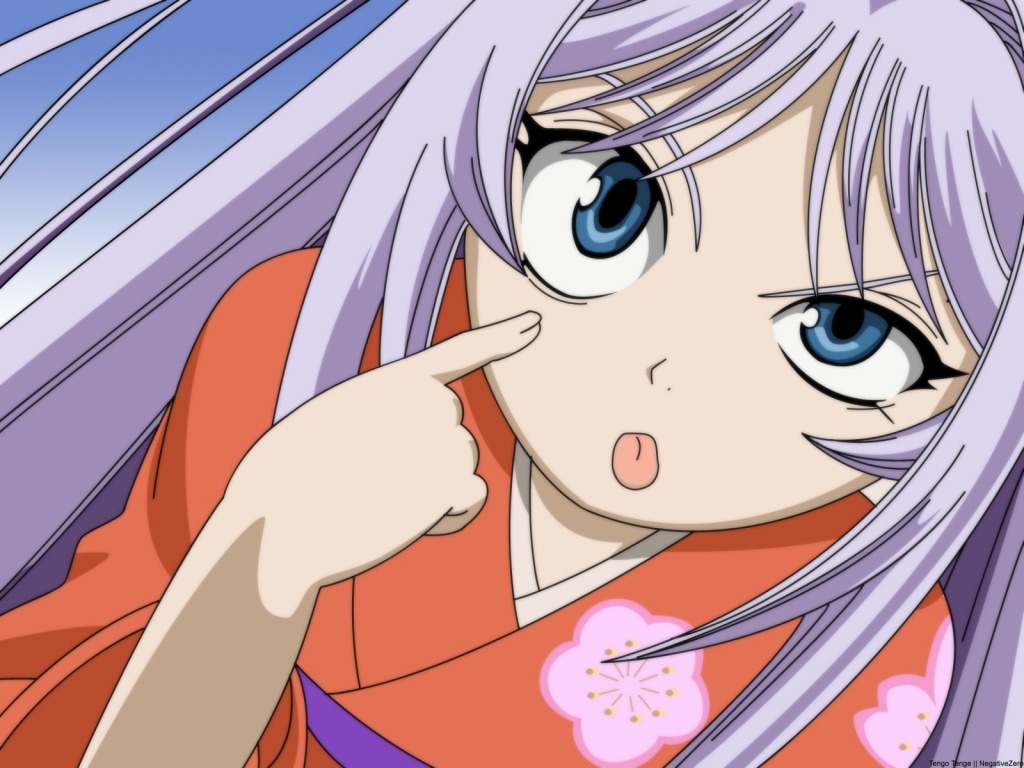
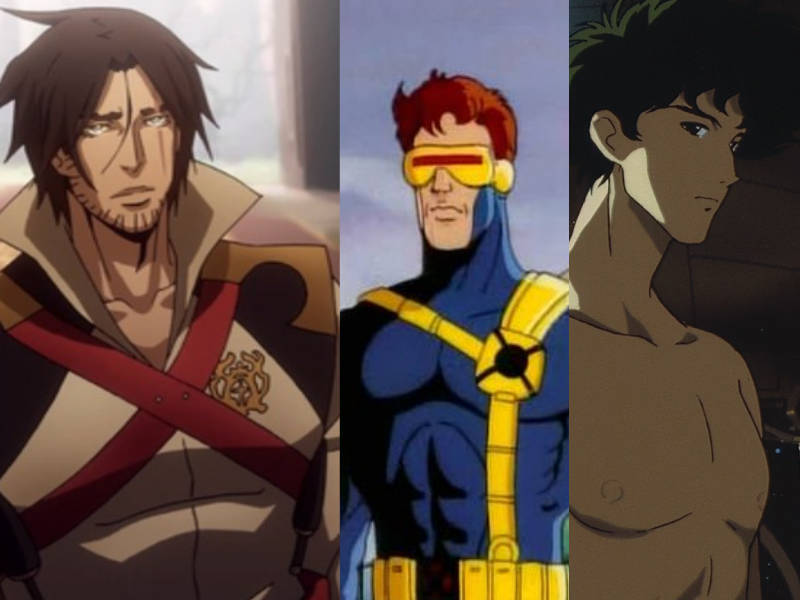
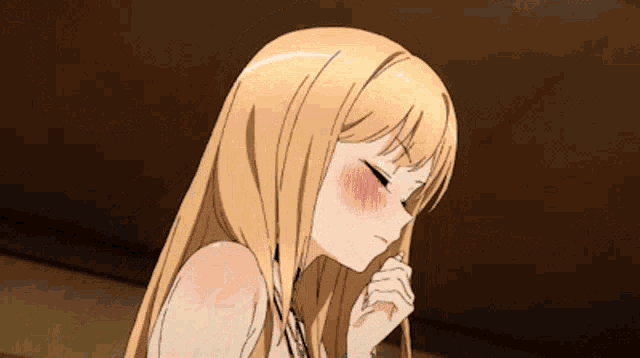
An interesting analysis! I now appreciate how Sousou no Frieren somewhat subverts the eye expectations. Frieren’s eyes are large and complex but rarely show emotion (fitting for her personality), but they also turn into her famous “UwU” eyes without irises when she’s lying or sleepy. On the other hand, Fern’s eyes seem simpler and narrower to me, but she uses her whole face to convey a wider range of emotions.
I noticed that eye subversion when I watched Frieren and Fern as well. Frieren’s simple eye design belies the depth of her experience and knowledge but suggests her problems with emotions–understanding her own and those of others. While tropes can be poorly used, tropes are needed to allow subversion and satire. I find the progress toward a modified version of 1980 character designs interesting. Designs remain influenced by the decades of moe anime has seen.